This article explains how to install WordPress with Nginx on Ubuntu 24.04.
Installing WordPress with Nginx support on Ubuntu can bring many benefits. Nginx, renowned for its high performance and low memory usage, is an excellent choice for serving WordPress sites. It efficiently handles many concurrent connections, which is particularly beneficial for high-traffic websites.
Furthermore, Nginx’s highly customizable configuration can effectively manage tasks like caching, load balancing, and SSL termination.
Integrating Nginx with WordPress on Ubuntu can significantly improve your website’s performance, scalability, and security and provide a reliable system.
The steps below walk you through installing WordPress with Nginx support on Ubuntu 24.04.
Install Nginx HTTP server on Ubuntu
WordPress requires a web server. For this post, we will install and use the Nginx web server to run WordPress.
To do that, open the Ubuntu terminal and run the commands below to install the Nginx web server.
sudo apt update
sudo apt install nginx
Once Nginx is installed, the commands below can start, stop, and enable the Nginx web server to start automatically when your server boots up.
sudo systemctl stop nginx
sudo systemctl start nginx
sudo systemctl enable nginx
You can test the Nginx web server by opening your web browser and browsing to the server’s localhost or IP address.
http://localhost
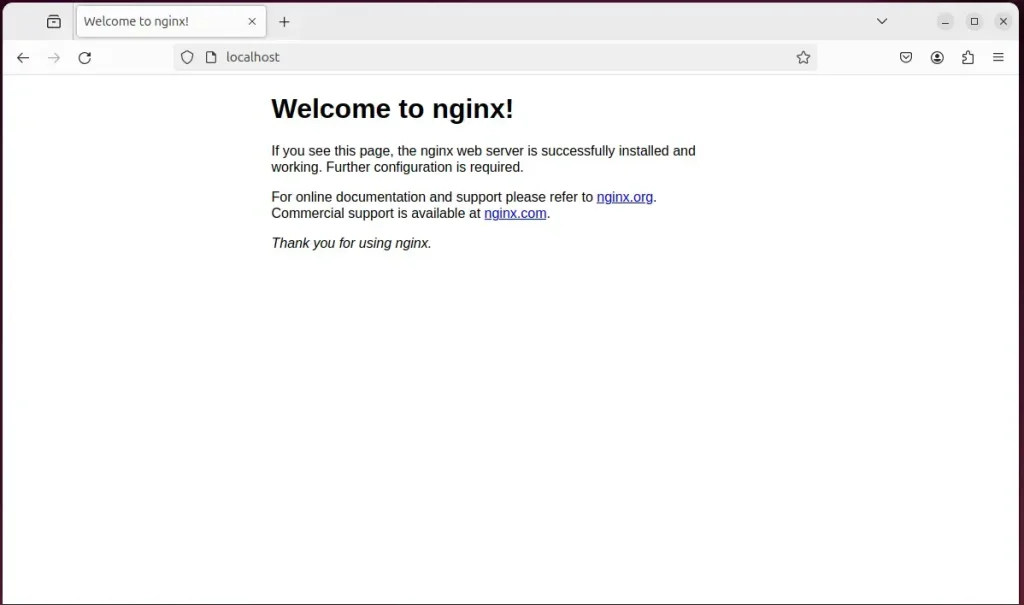
When you see “Welcome to nginx!” the Nginx HTTP server has been installed.
Additional help on installing Nginx on Ubuntu is in the link below.
How to install Nginx on Ubuntu
Install MariaDB database server on Ubuntu
The next component that is required to run WordPress is a database server. This post will install and use the MariaDB database server to run WordPress.
To install and use the MariaDB database server, use the instructions below.
Open the Ubuntu terminal and run the commands below to install the MariaDB database server.
sudo apt update sudo apt install mariadb-server
Once the MariaDB database server is installed, use the commands below to stop, start, and enable the MariaDB server to start automatically when the server boots.
sudo systemctl stop mariadb sudo systemctl start mariadb sudo systemctl enable mariadb
Run the following commands to validate and test if the MariaDB database server is installed successfully.
sudo mariadb
Once you run the commands above, it will log you onto the MariaDB console and display a message similar to the one below.
Welcome to the MariaDB monitor. Commands end with ; or \g. Your MariaDB connection id is 32 Server version: 10.11.2-MariaDB-1 Ubuntu 23.04 Copyright (c) 2000, 2018, Oracle, MariaDB Corporation Ab and others. Type 'help;' or '\h' for help. Type '\c' to clear the current input statement. MariaDB [(none)]>
The message tells you that the server is installed successfully.
Additional help on installing MariaDB.
Create a WordPress database
Upon successful installation of the MariaDB database server, create a blank database on the server specifically for the WordPress application.
As part of the setup, we will create a database named ‘wordpressdb ‘and a corresponding user account called ‘wordpressdbuser ‘.
Finally, we’ll grant the wordpressdbuser full access to the wordpressdb database.
All the database steps above can be done using the commands below:
But first, log on to the MariaDB database server:
sudo mariadb
Then run the commands below to complete the steps:
CREATE DATABASE wordpressdb CHARACTER SET utf8mb4 COLLATE utf8mb4_general_ci;
CREATE USER wordpressdbuser@localhost IDENTIFIED BY 'type_your_password_here';
GRANT ALL ON wordpressdb.* TO wordpressdbuser@localhost WITH GRANT OPTION;
FLUSH PRIVILEGES;
exit
Ensure to replace ‘type_your_password_here‘ with your password.
Install PHP-FPM on Ubuntu
The last component you will need to run WordPress is PHP-FPM. WordPress is a PHP application that supports the latest PHP versions.
Run the commands below to install PHP-FPM.
sudo apt install php-fpm php-intl php-mysql php-curl php-cli php-zip php-xml php-gd php-common php-mbstring php-xmlrpc php-json php-sqlite3 php-soap php-zip
Additional help on installing PHP
How to install PHP on Ubuntu Linux
Download WordPress files
Let’s begin the straightforward process of downloading and configuring the WordPress files on Ubuntu Linux.
First, navigate to the /tmp/ directory and download WordPress files. After unzipping the file, move the content into the WordPress folder in the Nginx root directory.
The final step is to change the permissions. This will allow the Nginx web server to safely interact with the files, ensuring a secure environment for your WordPress installation.
cd /tmp/
wget https://wordpress.org/latest.tar.gz
tar -xvzf latest.tar.gz
sudo mv wordpress /var/www/wordpress
sudo chown -R www-data:www-data /var/www/wordpress/
Once you have completed all the above steps, continue below to configure the Nginx web server to serve the WordPress content.
Run the commands below to create a Nginx virtual host file for WordPress.
sudo nano /etc/nginx/sites-available/wordpress.conf
Then, copy and paste the content block below into the Nginx server block.
server {
listen 80;
listen [::]:80;
root /var/www/wordpress;
index index.php;
server_name wordpress.example.com www.wordpress.example.com;
location / {
try_files $uri $uri/ /index.php?$args;
}
location ~ \.php$ {
include snippets/fastcgi-php.conf;
fastcgi_pass unix:/var/run/php/php8.3-fpm.sock;
fastcgi_param SCRIPT_FILENAME $document_root$fastcgi_script_name;
include fastcgi_params;
}
}
Save the file.
Then, run the commands below to enable the virtual host and restart the Nginx server.
sudo ln -s /etc/nginx/sites-available/wordpress.conf /etc/nginx/sites-enabled/
sudo systemctl restart nginx.service
Setup Let’s Encrypt SSL/TLS for WordPress
You may want to install an SSL/TLS certificate to secure your WordPress site. Secure your WordPress installation with HTTPS from Let’s Encrypt.
Please read the post below for additional resources on installing and creating Let’s Encrypt SSL certificates for Nginx.
How to set up Let’s Encrypt SSL certificate for Nginx on Ubuntu Linux
Once you have restarted the Nginx web server, open your browser and browse to the server hostname or IP address defined in the Nginx server block.
http://wordpress.example.com
A WordPress installation wizard page should appear. Select the installation language and continue to the next page.
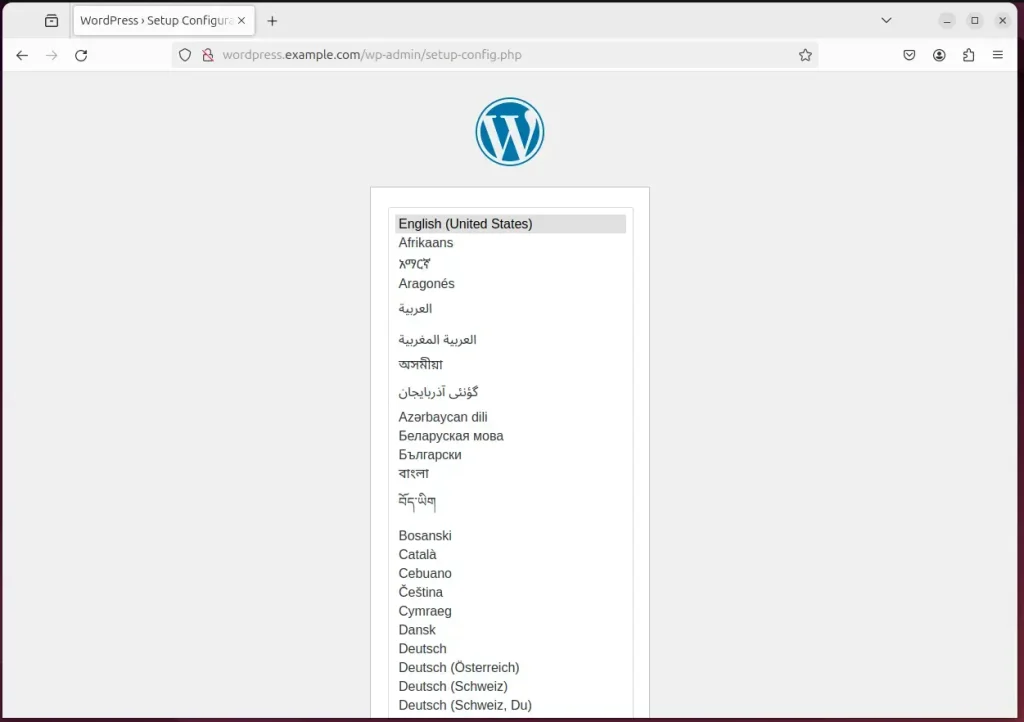
Next, click the Let’s go button to begin the installation process.
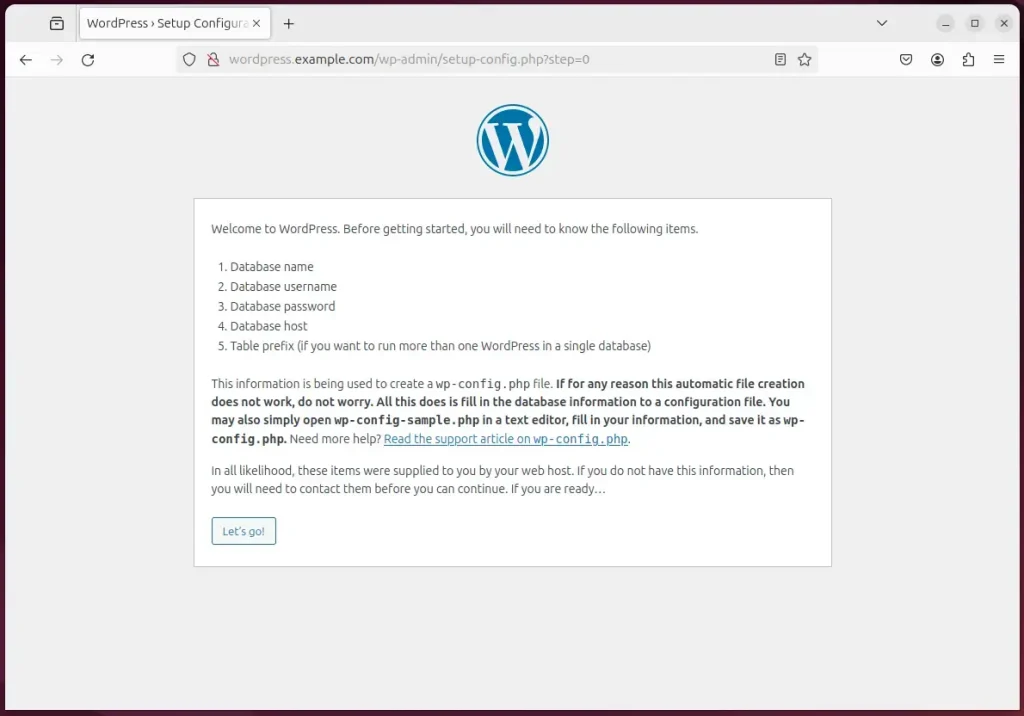
Type the database name, account name, and password on the next screen. Then, click Submit.
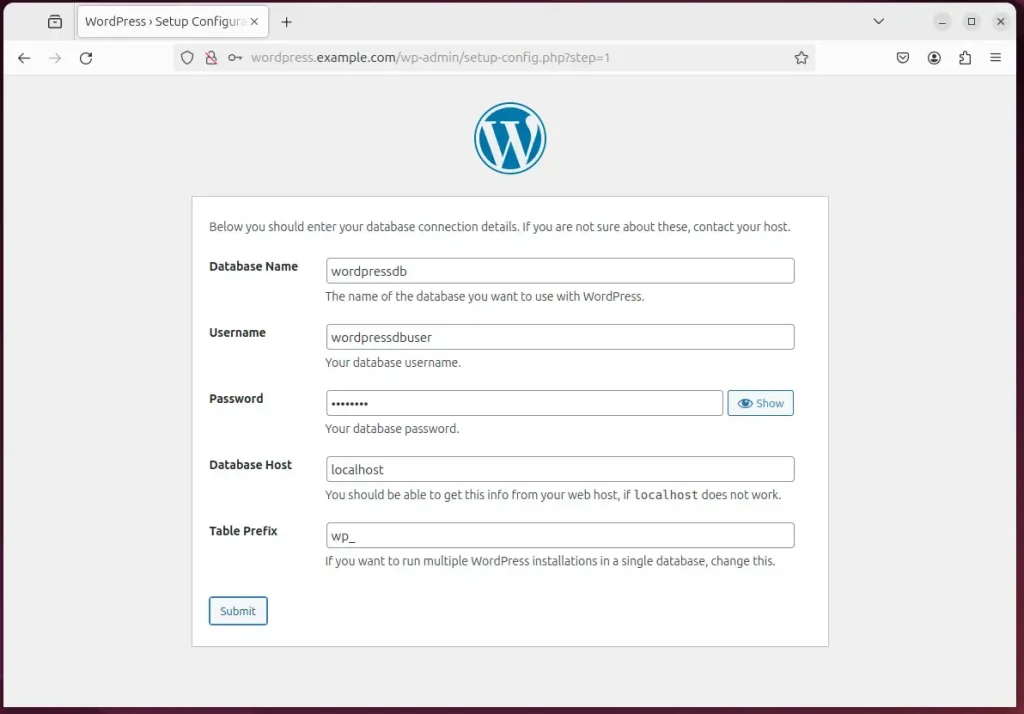
Next, click the “Run the installation” button to install WordPress files.
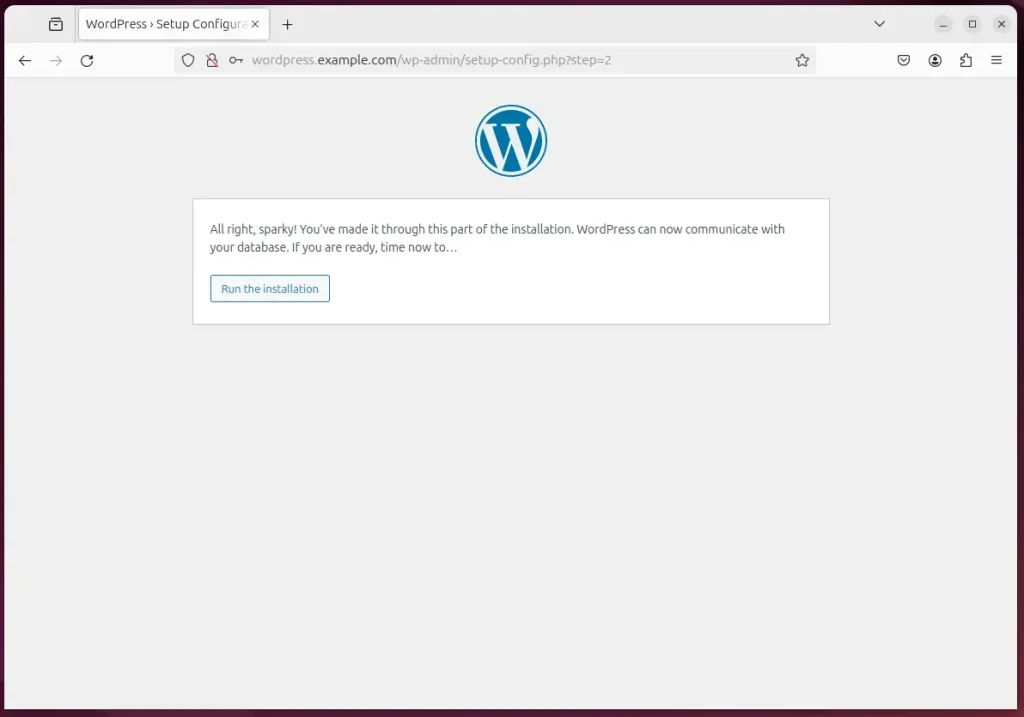
Next, type in the site title, admin account, email address, and password. Then, click “Install WordPress.”
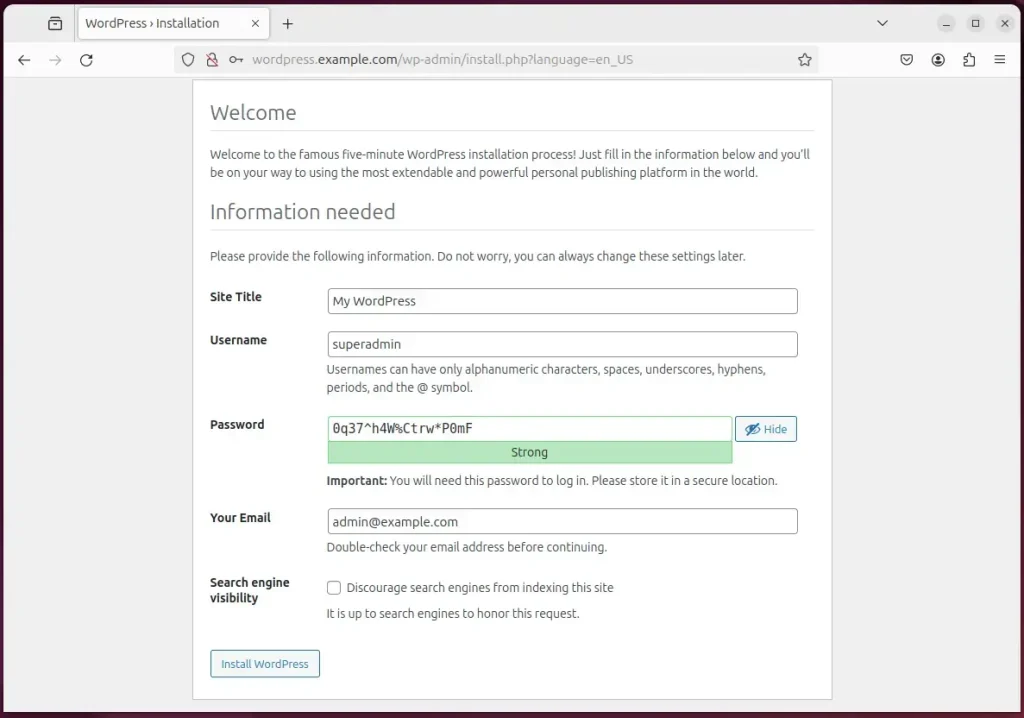
Your WordPress site should be set up and ready to use.
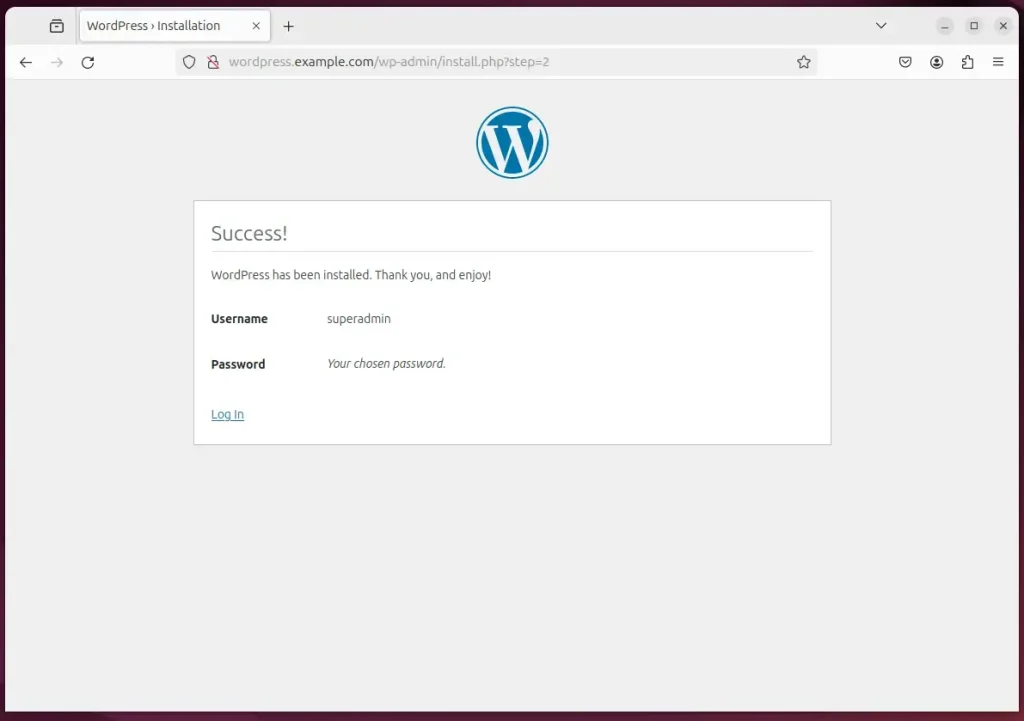
That should do it!
Conclusion:
- WordPress with Nginx support on Ubuntu 24.04 enhances website performance, scalability, and security.
- Nginx’s high performance, low memory usage, and customizable configuration make it an excellent choice for serving WordPress sites.
- Integrating Nginx with WordPress allows efficient management of tasks such as caching, load balancing, and SSL termination.
- The combination of Nginx, MariaDB, and PHP-FPM forms a reliable system for running WordPress on Ubuntu.
- Setting up Let’s Encrypt SSL/TLS certificates for Nginx further enhances the security of the WordPress installation.
This comprehensive guide offers a step-by-step approach to setting up WordPress with Nginx support on Ubuntu, ensuring a robust and secure foundation for your website.

Leave a Reply